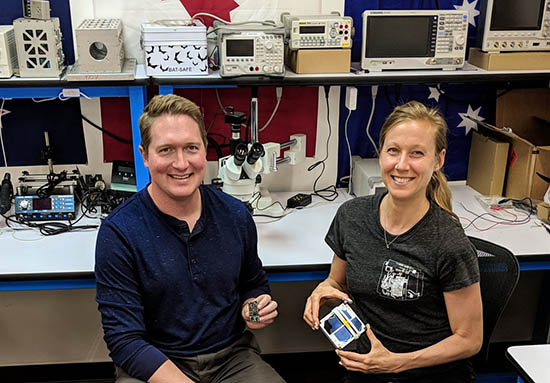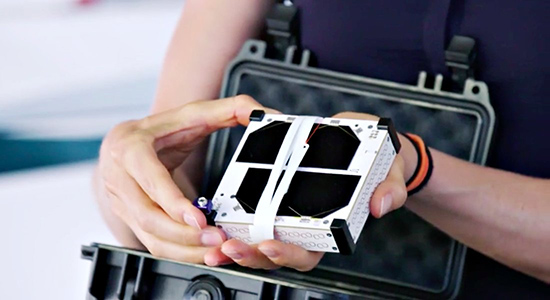这款卫星只有三明治大小,却能改变世界

|
下次碰到谷歌著名的“登月项目”负责人阿斯特罗·特勒,当他想溜过去时,咱们说好要问问他关于萨拉·斯潘格罗的事。斯潘格罗是太空工程师,经营着一家名叫Swarm Technologies的小型初创公司。她和联合创始人、苹果公司老臣本·隆米尔的大胆设想几乎就是一次成本要低得多的“登月”。
全球有几十亿较富裕的网民,但也有几十亿人缺乏前者的资源和基础设施,找到让这些人上网的最佳途径是人们几十年来的梦想。人造卫星看来好像是个显而易见的答案,但20世纪90年代的那些超大工程均未成行,埃隆·马斯克的Starlink等一些新方案则需要数千颗人造卫星(具体到Starlink,这个数字是1.2万颗),这就得很多很多次成功地发射火箭,需要耗资数十亿美元。马斯克和孙正义的OneWeb等方面都认为,商业化能极大地降低火箭发射成本,而摩尔定律可以让人造卫星实现令人难以置信的小型化,二者叠加在一起,或许就可以带来一个在经济上可行的解决方案吧。
Swarm Technologies的想法是把这些都做到极致。斯潘格罗和隆米尔靠的不是所谓鞋盒大小的立方星。Swarm Technologies的卫星更小,差不多像一块烤奶酪三明治。其天才之处在于他们发明了一种不需要推进器或喷射器就可以操纵卫星的方法(“正在申请专利”),他们用的是太空中的各种力量,如地球的磁场和太阳辐射。这就是Swarm Technologies的卫星能如此轻薄的原因。和斯潘格罗交流时,她对我的湖边隐喻表示赞同,我说Swarm Technologies的卫星是水上的帆船,而普通卫星是用汽车运到位的。Swarm Technologies卫星的体积和质量甚至只有与之竞争的小卫星的十二分之一,将其送入轨道的成本也只有后者的十二分之一。该公司的方案是用2500万美元和18个月来打造一个低成本网络,从而为世界上至少一部分地区提供网络连接,它非常适于发送短信或者从不断扩大的物联网中收集数据。Swarm Technologies在A轮融资中正好筹集了2500万美元,但这不是巧合。斯潘格罗说,他们的目标是“解决互联网的全球平价连接问题”。PayPal前首席运营官、Yammer首席执行官,同时也是领投Swarm Technologies的风投资本家大卫·萨克斯补充道:“在世界上任何地点便捷而廉价地连接任何设备是一种变革性能力,以前从未有过。” |
The next time one of us runs into Astro Teller, the head of Google’s famed “Moonshot factory,” as he skates by let’s agree to ask him about Sara Spangelo. She’s the aerospace engineer who runs a little startup called Swarm Technologies. And her big brainstorm, created with co-founder and Apple veteran Ben Longmier, is almost a literal moonshot at a much cheaper price.
People have been dreaming for decades about the best way to bring online the next couple of billion people who lack the resources and infrastructure of the wealthier few billion who are already online. Space satellites seem like an obvious answer but the mega-projects of the 1990s never got off the ground and more recent plans like Elon Musk’s Starlink would require thousands of satellites (about 12,000 in his particular case) thus requiring many, many successful rocket launches and costing billions of dollars. Musk and others, including Masayoshi Son’s OneWeb, think that the incredible decrease in launch costs due to commercialization plus the incredible miniaturization of satellites due to Moore’s Law will add up to an economically viable solution. Maybe.
Swarm’s ideas take those trends to the max. Spangelo and Longmier aren’t relying on so-called cube sats, which are about the size of a shoebox. Swarm’s satellites are even smaller, more the size of a grilled cheese sandwich. The genius part is they’ve invented a way (“patent pending”) to steer their craft without thrusters or jets, instead relying on various currents coursing through space like the earth’s magnetic field and the sun’s solar radiation. That’s why they can be so small and thin. When I talked to Spangelo she agreed with my lakeside metaphor that Swarm’s satellites sail about while typical satellites motor into position. At 1/12th the volume and mass of even rival small satellites, they cost about 1/12th as much to put into orbit. Now you’re talking about spending $25 million-ish dollars and 18 months to create a low-cost network providing at least some connectivity worldwide, perfect for texting or collecting data from the growing Internet of Things. Not coincidentally, Swarm just raised that amount in its Series A funding. The goal is “solving for affordable, global internet connectivity,” Spangelo says. David Sacks, the former COO of PayPal and CEO of Yammer and now a lead VC backing Swarm, adds that “the ability to connect any device easily and cheaply, anywhere in the world is transformational—it’s never existed before.” |

|
斯潘格罗在特勒的X实验室中工作了一年(正式工作是“Wing”无人机项目),此前她在美国国家航空航天局的Jet Propulsion Laboratory任职。她说自己曾经提出过Swarm Technologies采用的想法,但X实验室没有就此采取行动。
特勒曾解释说,X实验室的任务是找出那些听起来“真正科幻”的项目,这些项目也许无法实现,但如果可行,就能给世界带来“真正、巨大、积极的意义”。从很多方面来说Swarm Technologies都符合这样的标准,只是它提供的是低速网络连接,而非(马斯克、孙正义等人承诺的)宽带,这或许是个缺陷。不过,感谢这几家让人惊喜的风投机构,我们会找到答案。(财富中文网) 译者:Charlie 审校:夏林 |
Spangelo worked for a year at X under Teller (on the “Wing” drone project, officially) after a stint at NASA’s Jet Propulsion Laboratory. She says she pitched the idea behind Swarm, but X didn’t go for it.
Teller has explained that X’s role is to find projects that sound “sufficiently like science fiction” that they might not be possible and that would be “really audaciously positive” for the world if they could work. In a lot of ways, it seems like Swarm meets the test, though maybe the provision of only relatively slow connectivity instead of broadband (as Musk, Son, and others promise) was the breaking point. Still, thanks to a few enraptured VCs, we’re going to find out. |













